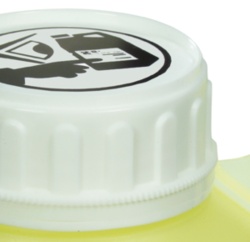The Good Fight Against Illicit Trade

If there was a face of the crop protection industry’s anti-counterfeiting movement, it would be D’Arcy Quinn, head of anti-counterfeiting at CropLife International.
When he’s not meeting with crop protection companies, regulators or legislators, Quinn is in the field examining the direct, harmful effects counterfeit crop protection products cause.
“All companies from industries with successful products are facing problems of counterfeiting. So, this is not limited to pesticides,” he says.
Quinn has been around the world, lending a hand to regulators and authorities in tracking illegal trade, visiting warehouses filled with counterfeit products and educating members of the supply chain including producers, vessel owners and farmers about recognizing a counterfeit or illegal products.
Each year, thousands of tons of counterfeit products cross borders, totaling 5% to 10% of total crop protection sales in markets such as the EU, or $4 billion of the global crop protection industry. Illegal products in many emerging markets constitute almost half of all pesticides applied. Although no official estimates are available as it is difficult to measure illegal trade volume, more than 2,500 tons of counterfeit products were seized by EU and non-EU authorities in 2011, a significant increase from the just more than 500 tons seized in 2010, according to the European Crop Protection Association.
Industry advocates from CropLife International to the Big 6 crop protection companies are now recognizing the increasing need to crack down on counterfeit and illegal trade.
While counterfeit or illegal trade seems to be the most pervasive in India, China, Africa, Ukraine, Paraguay, Uruguay and Russia, no one individual country or region is liable as new avenues for illegal trade can open up anywhere.
“Individual countries do not contribute to the trade of counterfeit pesticides, criminals do,” Quinn says. “We should not blame a country, as the source can shift. Countries that do not have strict import regulations and law enforcement tend to be the most susceptible to the import of counterfeit products.”
Crop protection companies, governments and national trade organizations are working together to ramp up regulations, improve policies and create stricter, more explicit guidelines to combat illegal and counterfeit pesticide trade.
Revising Regulations
The crop protection industry first noticed counterfeit trading becoming more prevalent about seven years ago.
BASF has seen counterfeiting cases of its products, most frequently diemthoate, alpha cypermethrin and epoxiconazole increase in the past seven years. The impact of these counterfeit products ranges from crop devastation, damaged crops due to wrong AI or low concentration or absence of any AI and potential endangerment of health of operator due to banned inerts in faked products.
A key success factor is enforcement by customs and changes in regulation, says Dr. Detlef Doehnert, director of supply chain stewardship, BASF Crop Protection.
“The revision of Regulation (EC) No 1383/2003, the EU legislation on transit goods, is a step in the right direction,” he says.
Regulation No 1383/2003 addresses customs action against goods suspected of infringing certain intellectual property rights, the rights of custom authorities to enforce the regulation and what measures are taken when counterfeit goods are discovered.
One major problem stems from lack of accountability on the part of vessel companies.
Countries that receive counterfeit products need to become more aggressive in pursuing counterfeits into their destination countries, Quinn says.
Patent rights and enforcement also need to be examined, says Utz Klages, Bayer CropScience spokesperson for crop protection and environmental science.
“Strong patent protection is a requisite for a long-standing commitment to innovation,” he says.
Bayer CropScience has developed a Product Defense Team that works with national and international authorities, which has led to numerous seizures of counterfeits in a
number of countries.
The company also participates in close inspection of freight and consignors/consignees in collaboration with shipping companies.
Klages echoes the other attitudes surrounding vessel companies. He says transport companies such as shipping lines, airlines and freight forwarders need to take their share of responsibility by exercising due diligence to avoid the shipment of illegal consignments from known producers of counterfeits to known receivers of these illegal goods in the EU.
“Customs and other law enforcement authorities need to be empowered to address false and intentional false declarations of shipments besides pure intellectual property infringements, even if shipments of illegal pesticides are supposedly ‘in transit’ through Europe,” Klages says.
The End User
If efforts fail to stop counterfeit crop protection products from entering a certain country, it is up to farmers and growers to determine which products are legitimate.
“Counterfeits negatively impact all industries, but the cost of using counterfeit and illegal pesticides has a potential negative impact on farmers,” Quinn says. “If farmers suffer any loss or damage of crops from the use of counterfeit products, they have no legitimate company to turn to for advice and support.”
A new packaging design developed by Bayer CropScience intends to transform generic industrial packaging into Bayer-specific, counterfeit-resistant packaging, Klages says.
BASF implements technical means to authenticate BASF products such as marker technology and product intrinsic characteristics, Dr. Doehnert says.
“Marker technologies and product intrinsic characteristics are part of a comprehensive concept to protect the products and product users,” he says. “The concept also includes activities like public information and training sessions for customs authorities. All additional measures are flexible and tailored to local market needs.”
In addition, both the European Crop Protection Association and CropLife International have been collaborating on initatives to provide training for distributors, farmers and governmental agencies to recognize counterfeit and illegal crop protection products.
“It is impossible to accurately measure an illegal activity. What we are aware of is that seizures of counterfeit pesticides in the EU are growing,” Quinn says. “All companies with a counterfeit problem need to work with customs and law enforcement officials to stop counterfeit products from entering the country. They also need to raise awareness with the entire value chain and especially with potential end users.”





